*NURSING > TEST BANK > Test Bank - Maternity and Pediatric Nursing (3rd Edition) by Ricci, Kyle, and Carman (All)
Test Bank - Maternity and Pediatric Nursing (3rd Edition) by Ricci, Kyle, and Carman
Document Content and Description Below
Test Bank Maternity and Pediatric Nursing 3rd Edition By Susan Ricci, Theresa Kyle, and Susan CarmanTest Bank - Maternity and Pediatric Nursing (3rd Edition) by Ricci, Kyle, and Carman 2 Contents ... Chapter 1- Perspectives on Maternal, Newborn, and Women’s Health Care ................................................................4 Chapter 2- Family-Centered Community-Based Care....................................................................................................9 Chapter 3- Anatomy and Physiology of the Reproductive System...............................................................................14 Chapter 4- Common Reproductive Issues ....................................................................................................................19 Chapter 5- Sexually Transmitted Infections.................................................................................................................24 Chapter 6- Disorders of the Breasts .............................................................................................................................29 Chapter 7- Benign Disorders of the Female Reproductive Tract..................................................................................34 Chapter 8- Cancers of the Female Reproductive Tract.................................................................................................39 Chapter 9- Violence and Abuse ...................................................................................................................................44 Chapter 10- Fetal Development and Genetics ..............................................................................................................49 Chapter 11- Maternal Adaptation During Pregnancy ...................................................................................................54 Chapter 12- Nursing Management During Pregnancy..................................................................................................60 Chapter 13- Labor and Birth Process ...........................................................................................................................66 Chapter 14- Nursing Management During Labor and Birth .........................................................................................72 Chapter 15- Postpartum Adaptations ...........................................................................................................................78 Chapter 16- Nursing Management During the Postpartum Period ...............................................................................84 Chapter 17- Newborn Transitioning ............................................................................................................................90 Chapter 18- Nursing Management of the Newborn......................................................................................................96 Chapter 19- Nursing Management of Pregnancy at Risk- Pregnancy.........................................................................102 Chapter 20- Nursing Management of the Pregnancy at Risk......................................................................................108 Chapter 21- Nursing Management of Labor and Birth at Risk...................................................................................114 Chapter 22- Nursing Management of the Postpartum Woman at Risk .......................................................................120 Chapter 23- Nursing Care of the Newborn With Special Needs.................................................................................126 Chapter 24- Nursing Management of the Newborn at Risk........................................................................................132 Chapter 25- Growth and Development of the Newborn and Infant ............................................................................138 Chapter 26- Growth and Development of the Toddler ...............................................................................................144 Chapter 27- Growth and Development of the Preschooler.........................................................................................150 Chapter 28- Growth and Development of the School-Age Child ...............................................................................157 Chapter 29- Growth and Development of the Adolescent..........................................................................................164 Chapter 30- Atraumatic Care of Children and Families .............................................................................................171 Chapter 31- Health Supervision .................................................................................................................................176 Chapter 32- Health Assessment of Children ..............................................................................................................183 Chapter 33- Caring for Children in Diverse Settings..................................................................................................190 Chapter 34- Caring for the Special Needs Child ........................................................................................................197 Chapter 35- Key Pediatric Nursing Interventions ......................................................................................................203 Chapter 36- Pain Management in Children ................................................................................................................210 Chapter 37- Nursing Care of the Child With an Infectious or Communicable Disorder ............................................217 Chapter 38- Nursing Care of the Child With an Alteration in Intracranial Regulation / Neurologic Disorder ...........224Test Bank - Maternity and Pediatric Nursing (3rd Edition) by Ricci, Kyle, and Carman 3 Chapter 39- Nursing Care of the Child With an Alteration in Sensory Perception / Disorder of the Eyes or Ears .....231 Chapter 40- Nursing Care of the Child With an Alteration in Gas Exchange / Respiratory Disorder.........................238 Chapter 41- Nursing Care of the Child With an Alteration in Perfusion / Cardiovascular Disorder...........................244 Chapter 42- Nursing Care of the Child With an Alteration in Bowel Elimination / Gastrointestinal Disorder...........250 Chapter 43- Nursing Care of the Child With an Alteration in Urinary Elimination / Genitourinary Disorder............257 Chapter 44- Nursing Care of the Child With an Alteration in Mobility / Neuromuscular or Musculoskeletal Disorder ...................................................................................................................................................................................264 Extra Questions: Musculoskeletal Disorder...........................................................................................................270 Chapter 45- Nursing Care of the Child With an Alteration in Tissue Integrity / Integumentary Disorder..................277 Chapter 46- Nursing Care of the Child With an Alteration in Cellular Regulation / Hematologic or Neoplastic Disorder .....................................................................................................................................................................283 Extra Questions: Neoplastic Disorder....................................................................................................................290 Chapter 47- Nursing Care of the Child With an Alteration in Immunity or Immunologic Disorder...........................296 Chapter 48- Nursing Care of the Child With an Alteration in Metabolism / Endocrine Disorder...............................303 Chapter 49- Nursing Care of the Child With an Alteration in Genetics .....................................................................310 Chapter 50- Nursing Care of the Child With an Alteration in Behavior, Cognition, or Development........................317 Chapter 51- Nursing Care During a Pediatric Emergency..........................................................................................324Test Bank - Maternity and Pediatric Nursing (3rd Edition) by Ricci, Kyle, and Carman 4 Chapter 1- Perspectives on Maternal, Newborn, and Women’s Health Care 1. The United States ranks 50th in the world for maternal mortality and 41st among industrialized nations for infant mortality rate. When developing programs to assist in decreasing these rates, which factor would most likely need to be addressed as having the greatest impact? A) Resolving all language and cultural differences B) Assuring early and adequate prenatal care C) Providing more extensive women’s shelters D) Encouraging all women to eat a balanced diet 2. When integrating the principles of family-centered care, the nurse would include which of the following? A) Childbirth is viewed as a procedural event B) Families are unable to make informed choices C) Childbirth results in changes in relationships D) Families require little information to make appropriate decisions 3. When preparing a teaching plan for a group of first-time pregnant women, the nurse expects to review how maternity care has changed over the years. Which of the following would the nurse include when discussing events of the 20th century? A) Epidemics of puerperal fever B) Performance of the first cesarean birth C) Development of the x-ray to assess pelvic size D) Creation of free-standing birth centers 4. After teaching a group of students about pregnancy-related mortality, the instructor determines that additional teaching is needed when the students identify which condition as a leading cause? A) Hemorrhage B) Embolism C) Obstructed labor D) Infection 5. The nurse is working with a group of community health members to develop a plan to address the special health needs of women. Which of the following conditions would the group address as the major problem? A) Smoking B) Heart disease C) Diabetes D) Cancer 6. When assessing a family for possible barriers to health care, the nurse would consider which factor to be most important? A) LanguageTest Bank - Maternity and Pediatric Nursing (3rd Edition) by Ricci, Kyle, and Carman 5 B) Health care workers’ attitudes C) Transportation D) Finances 7. After teaching a group of nursing students about the issue of informed consent. Which of the following, if identified by the student, would indicate an understanding of a violation of informed consent? A) Performing a procedure on a 15-year-old without consent B) Serving as a witness to the signature process C) Asking whether the client understands what she is signing D) Getting verbal consent over the phone for emergency procedures 8. The nurse is trying to get consent to care for an 11-year-old boy with diabetic ketoacidosis. His parents are out of town on vacation, and the child is staying with a neighbor. Which action would be the priority? A) Getting telephone consent with two people listening to the verbal consent B) Providing emergency care without parental consent C) Contacting the child’s aunt or uncle to obtain their consent D) Advocating for termination of parental rights for this situation 9. After teaching nursing students about the basic concepts of family-centered care, the instructor determines that the teaching was successful when the students state which of the following? A) “Childbirth affects the entire family, and relationships will change.” B) “Families are not capable of making health care decisions for themselves.” C) “Mothers are the family members affected by childbirth.” D) “Childbirth is a medical procedure.” 10. A nursing instructor is preparing a class discussion on the trends in health care and health care delivery over the past several centuries. When discussing the changes during the past century, which of the following would the instructor be least likely to include? A) Disease prevention B) Health promotion C) Wellness D) Analysis of morbidity and mortality 11. A nurse is assigned to care for an Asian American client. The nurse develops a plan of care with the understanding that based on this client’s cultural background, the client most likely views illness as which of the following? A) Caused by supernatural forces. B) A punishment for sins. C) Due to spirits or demons. D) From an imbalance of yin and yang 12. A nurse is developing a plan of care for a woman to ensure continuity of care during pregnancy, labor, and childbirth. Which of the following would be most important for the nurse to incorporate into that plan? A) Adhering to strict, specific routinesTest Bank - Maternity and Pediatric Nursing (3rd Edition) by Ricci, Kyle, and Carman 6 B) Involving a pediatric physician C) Educating the client about the importance of a support person D) Assigning several nurses as a support team 13. A nursing instructor is preparing a class discussion on case management in maternal and newborn health care. Which of the following would the instructor include as a key component? Select all that apply. A) Advocacy B) Coordination C) Communication D) Resource management E) Event managed care 14. After teaching a group of students about the concept of maternal mortality, the instructor determines that additional teaching is needed when the students state which of the following? A) “The rate includes accidental causes for deaths.” B) “It addresses pregnancy-related causes.” C) “The duration of the pregnancy is not a concern.” D) “The time frame is typically for a specified year.” 15. A group of students are reviewing the historical aspects about childbirth. The students demonstrate understanding of the information when they identify the use of twilight sleep as a key event during which time frame? A) 1700s B) 1800s C) 1900s D) 2000s 16. A nurse is providing care to a woman who has just delivered a healthy newborn. Which action would least likely demonstrate application of the concept of family-centered care? A) Focusing on the birth as a normal healthy event for the family B) Creating opportunities for the family to make informed decisions C) Encouraging the woman to keep her other children at home D) Fostering a sense of respect for the mother and the family 17. When discussing fetal mortality with a group of students, a nurse addresses maternal factors. Which of the following would the nurse most likely include? Select all that apply. A) Chromosomal abnormalities B) Malnutrition C) Preterm cervical dilation D) Underlying disease condition E) Poor placental attachment 18. A nurse is preparing a presentation for a local community group about health status and children’s health. Which of the following would the nurse include as one of the most significant measures? A) Fetal mortality rateTest Bank - Maternity and Pediatric Nursing (3rd Edition) by Ricci, Kyle, and Carman 7 B) Neonatal mortality rate C) Infant mortality rate D) Maternal mortality rate 19. A group of students are reviewing an article describing information related to indicators for women’s health and the results of a national study. Which of the following would the students identify as being satisfactory for women? Select all that apply. A) Smoking cessation B) Colorectal cancer screening C) Violence against women D) Health insurance coverage E) Mammograms 20. A nurse is preparing a presentation for a local women’s group about heart disease and women. Which of the following would the nurse expect to address when discussing measures to promote health. A) Women have similar symptoms as men for a heart attack. B) Heart disease is no longer viewed as a “man’s disease.” C) Women experiencing a heart attack are at greater risk for dying. D) Heart attacks in women are more easily diagnosed. 21. A nurse is working to develop a health education program for a local community to address breast cancer awareness. Which of the following would the nurse expect to include when describing this problem to the group? Select all that apply. A) White women have higher rates of breast cancer than African American women. B) African American women are more likely to die from breast cancer at any age. C) Survival at any stage is worse among white women. D) Women living in South America have the highest rates of breast cancer. E) Breast cancer is the leading cause of cancer mortality in women. 22. A group of nursing students are reviewing information about factors affecting maternal, newborn, and women’s health. The students demonstrate understanding of the information when they identify which of the following deficiencies as being associated with poverty? Select all that apply. A) Literacy B) Employment opportunities C) Mobility D) Political representation E) Skills Answer Key 1. B 2. C 3. D 4. BTest Bank - Maternity and Pediatric Nursing (3rd Edition) by Ricci, Kyle, and Carman 8 5. B 6. D 7. A [Show More]
Last updated: 9 months ago
Preview 1 out of 329 pages
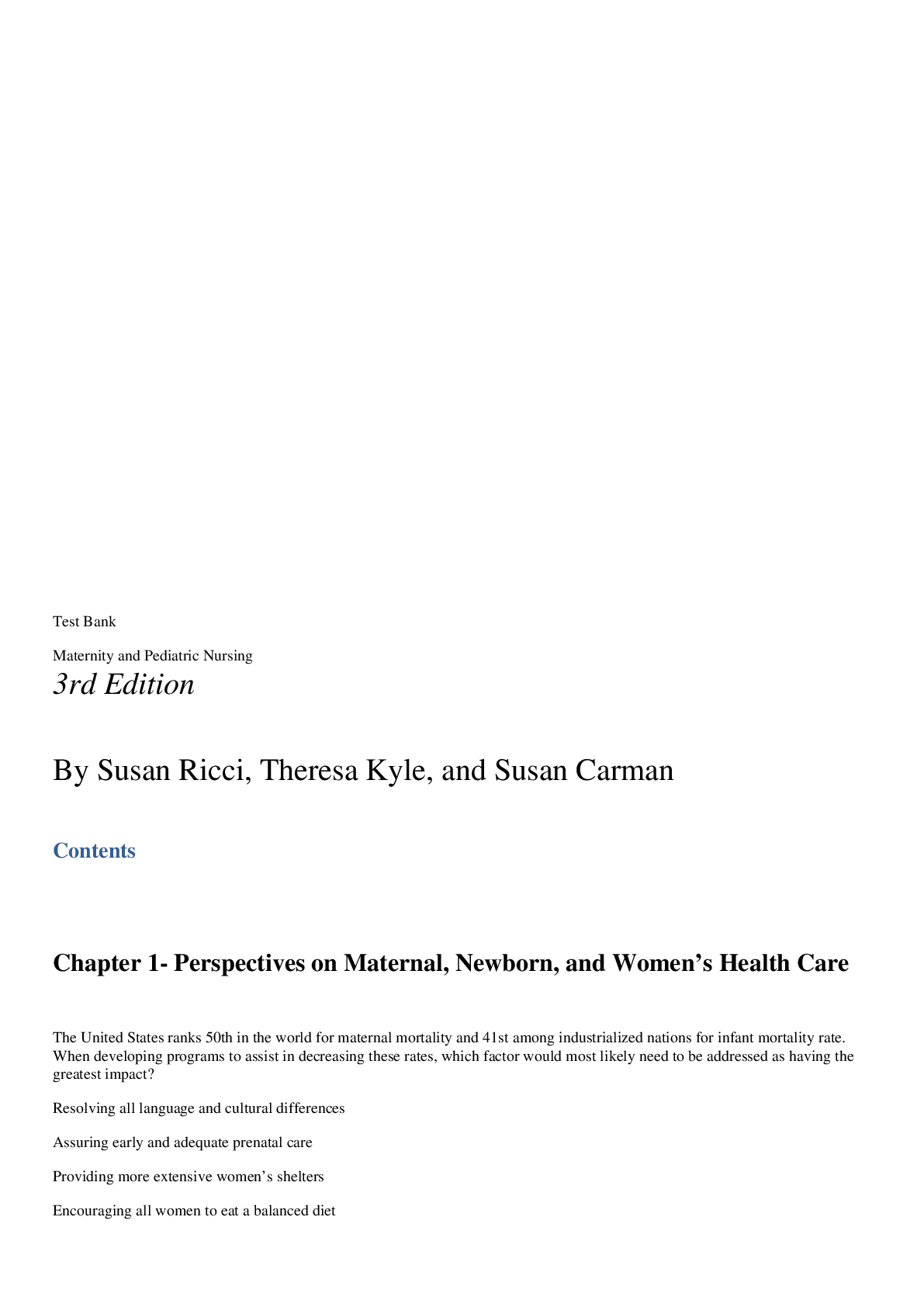
Reviews( 0 )
Document information
Connected school, study & course
About the document
Uploaded On
Aug 03, 2021
Number of pages
329
Written in
Additional information
This document has been written for:
Uploaded
Aug 03, 2021
Downloads
0
Views
51

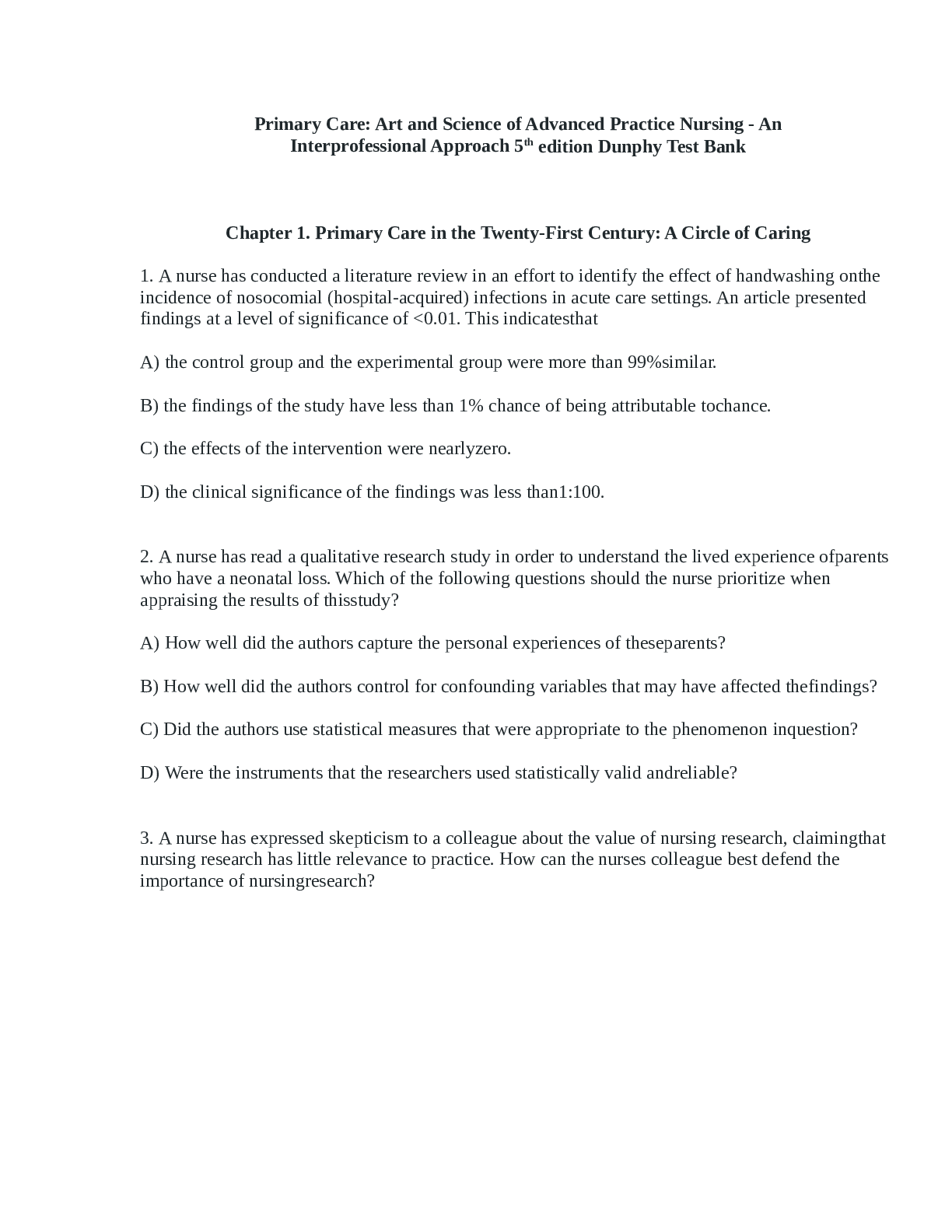
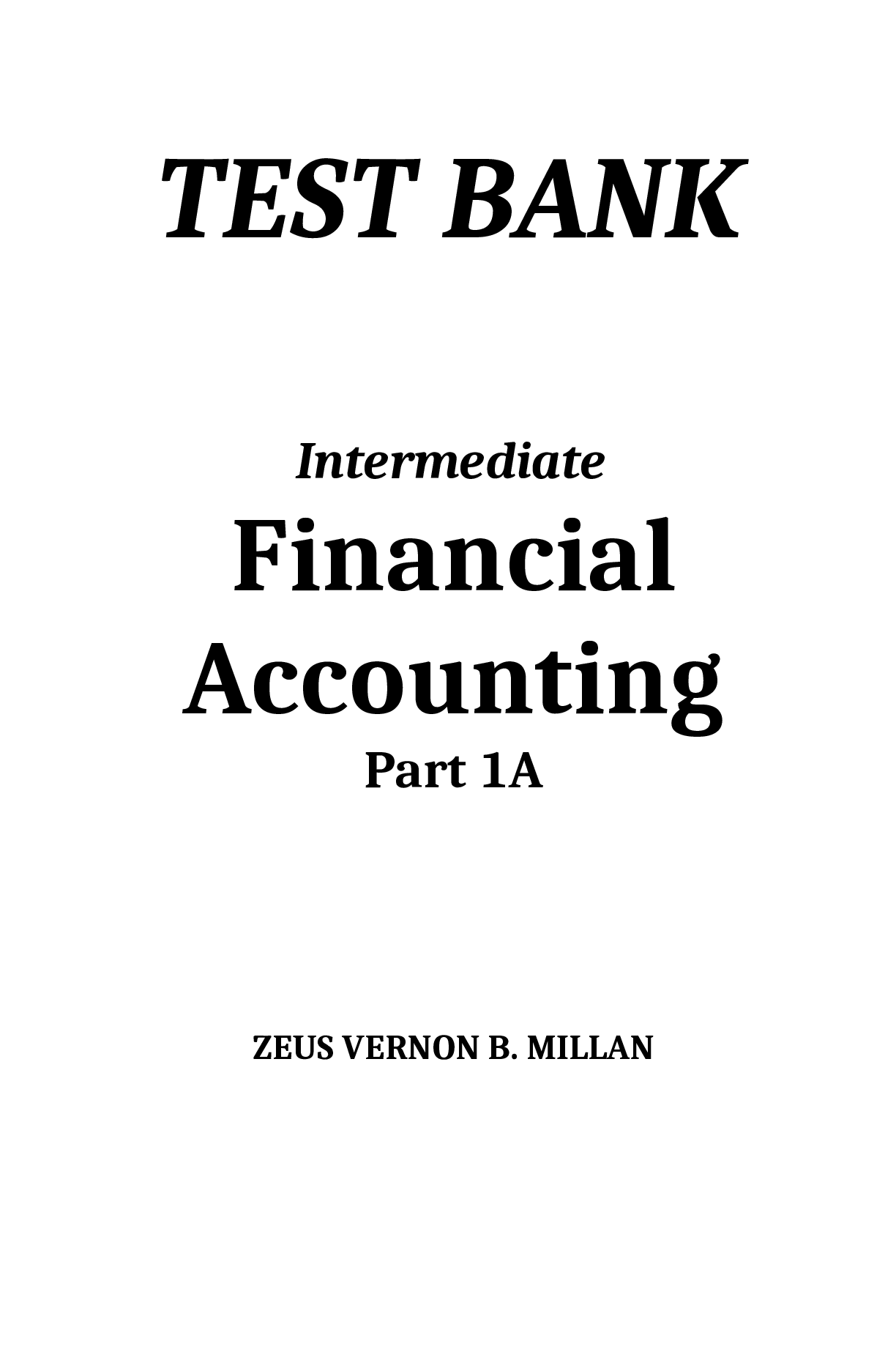
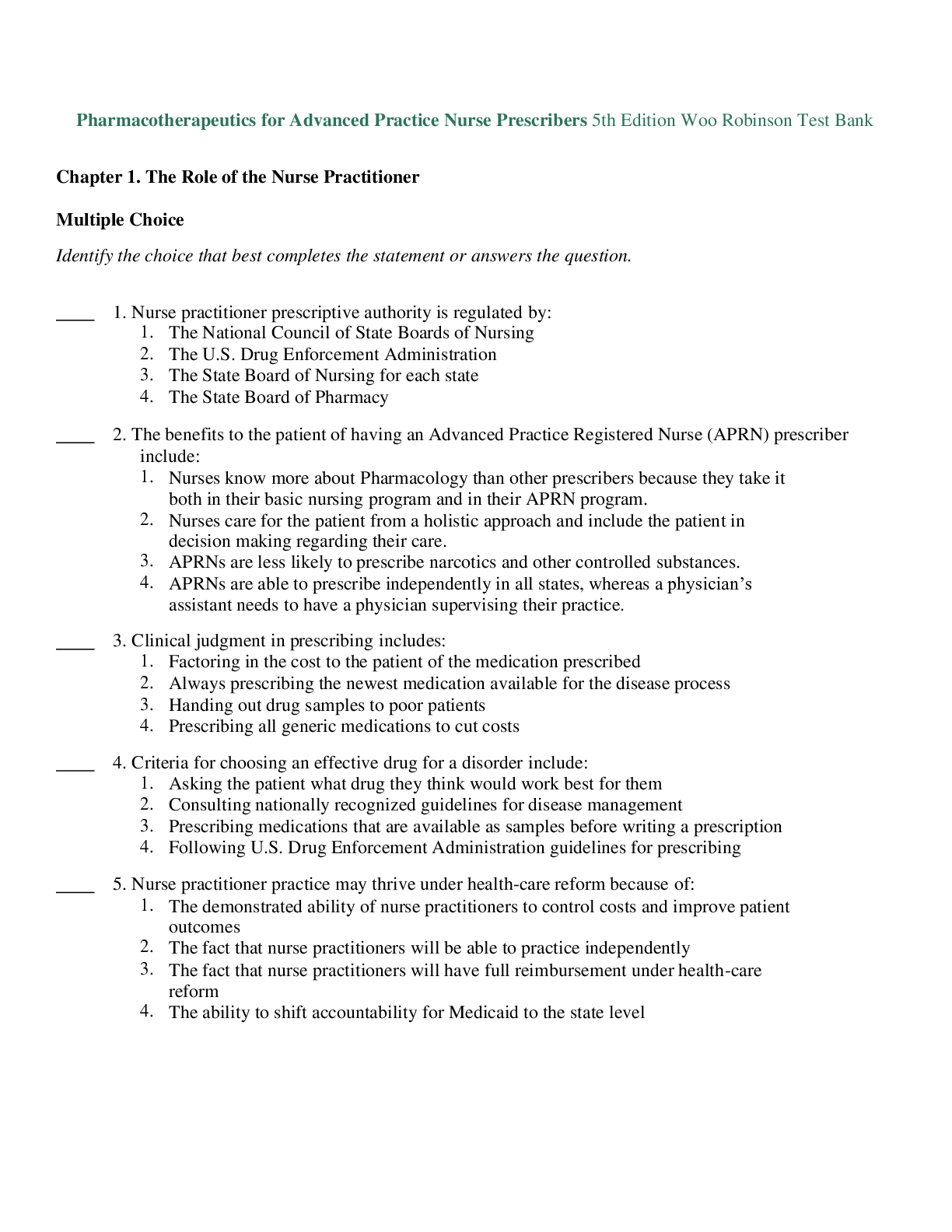
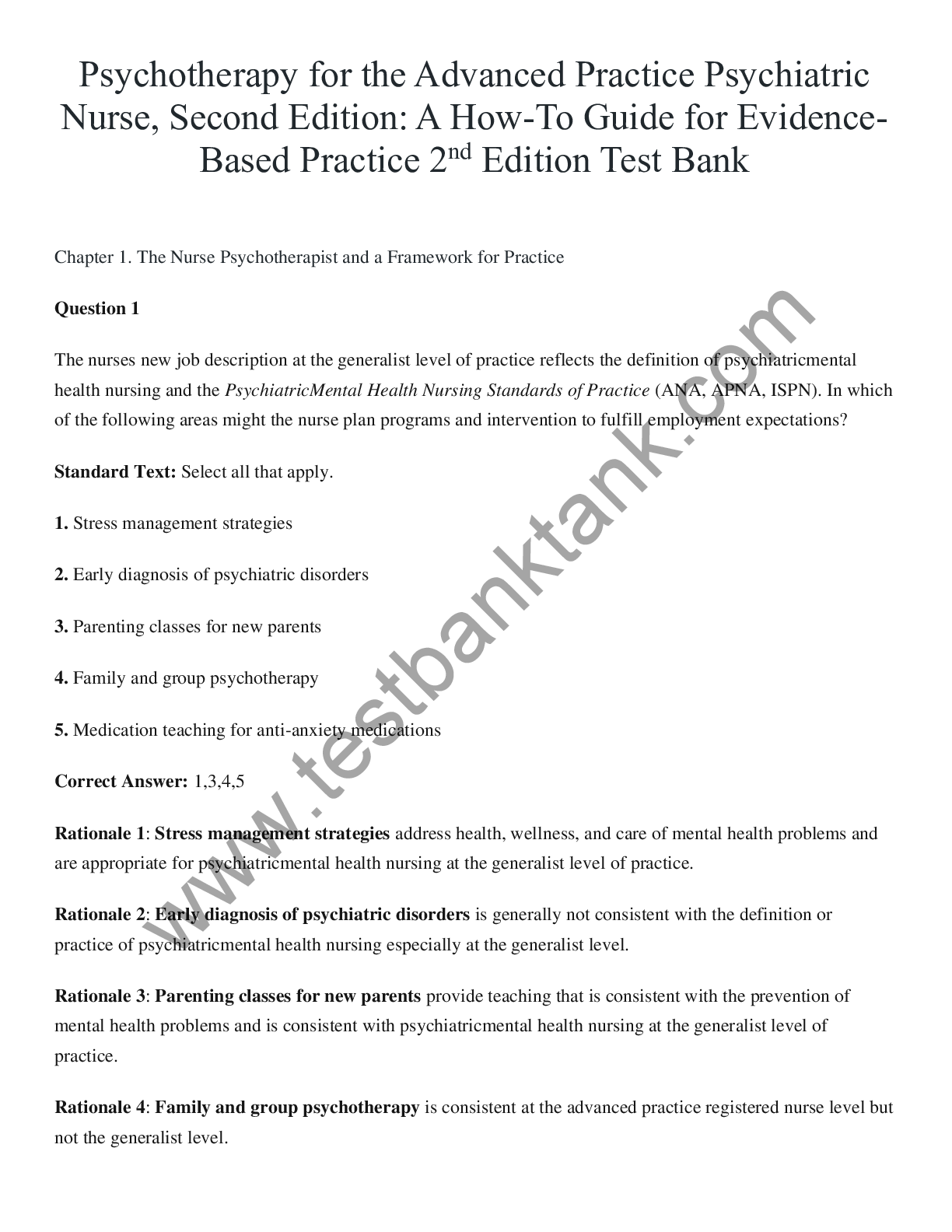
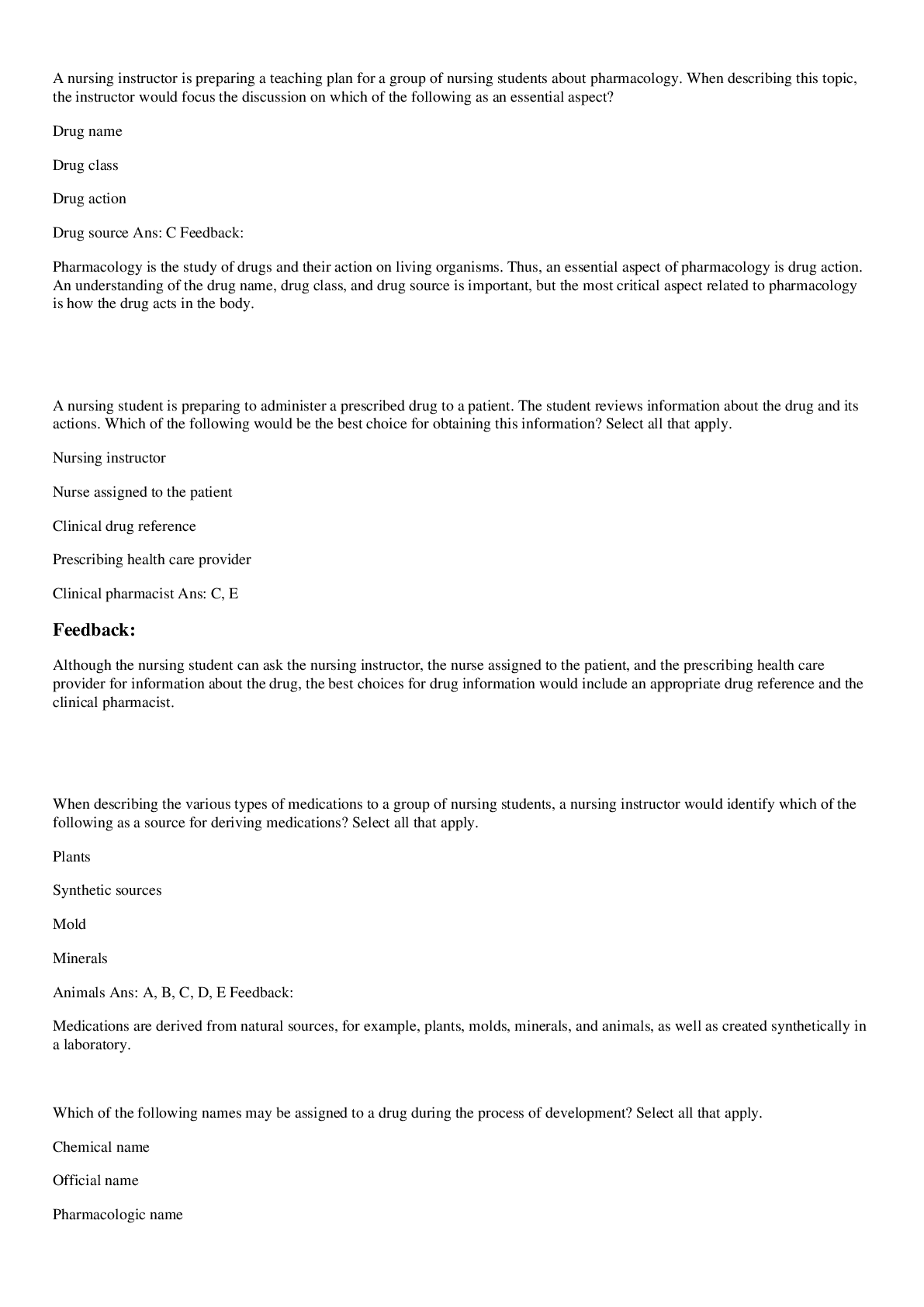
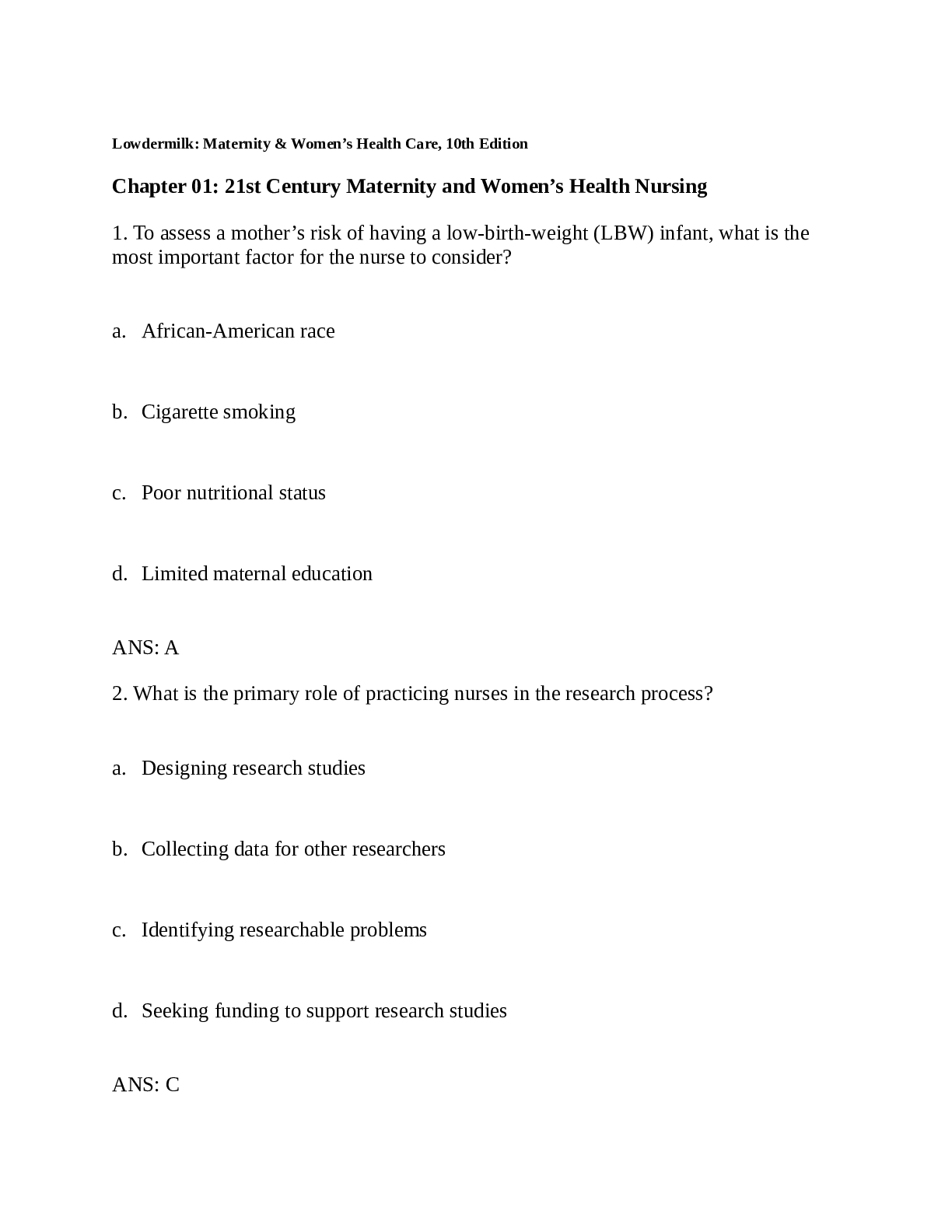
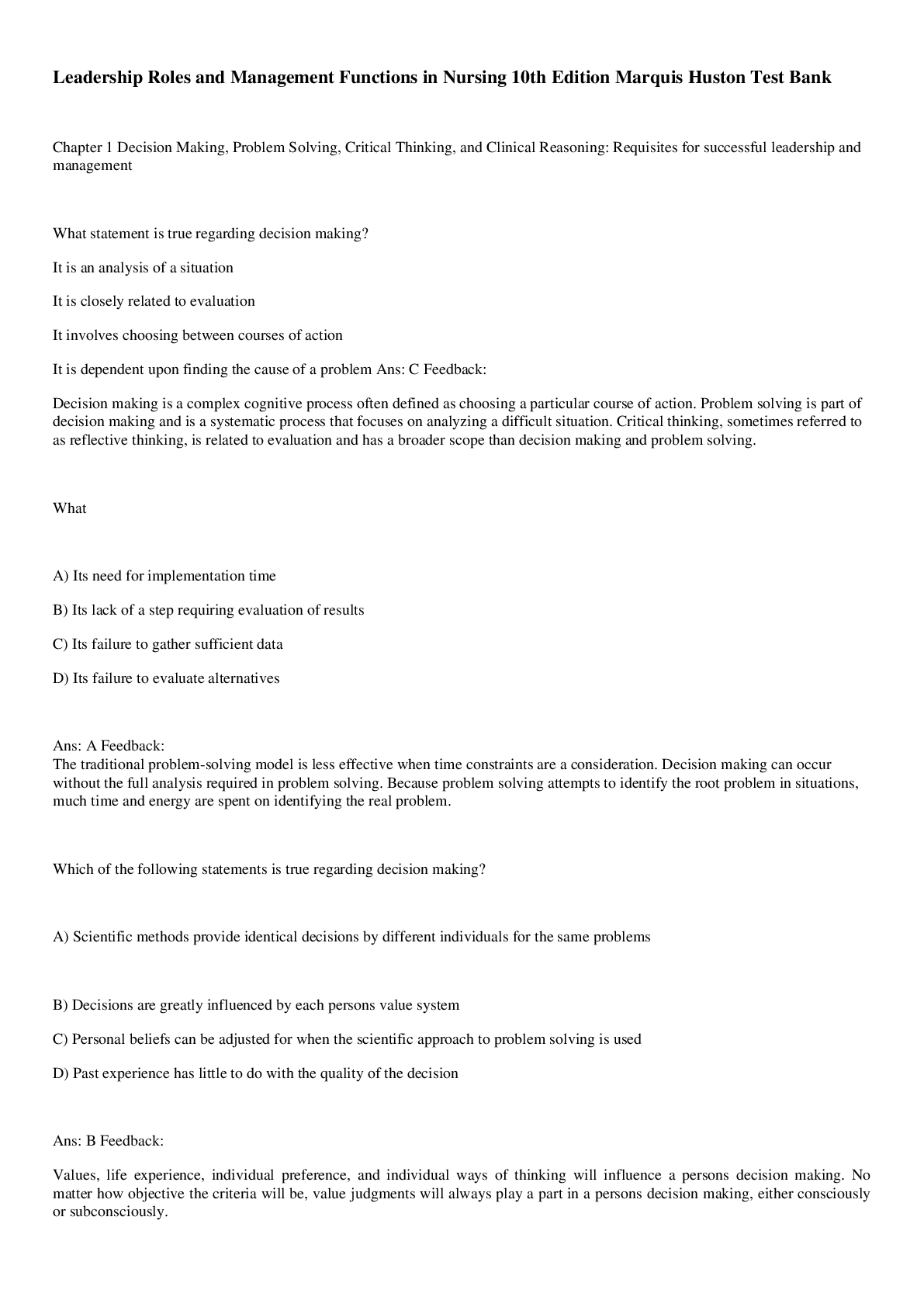
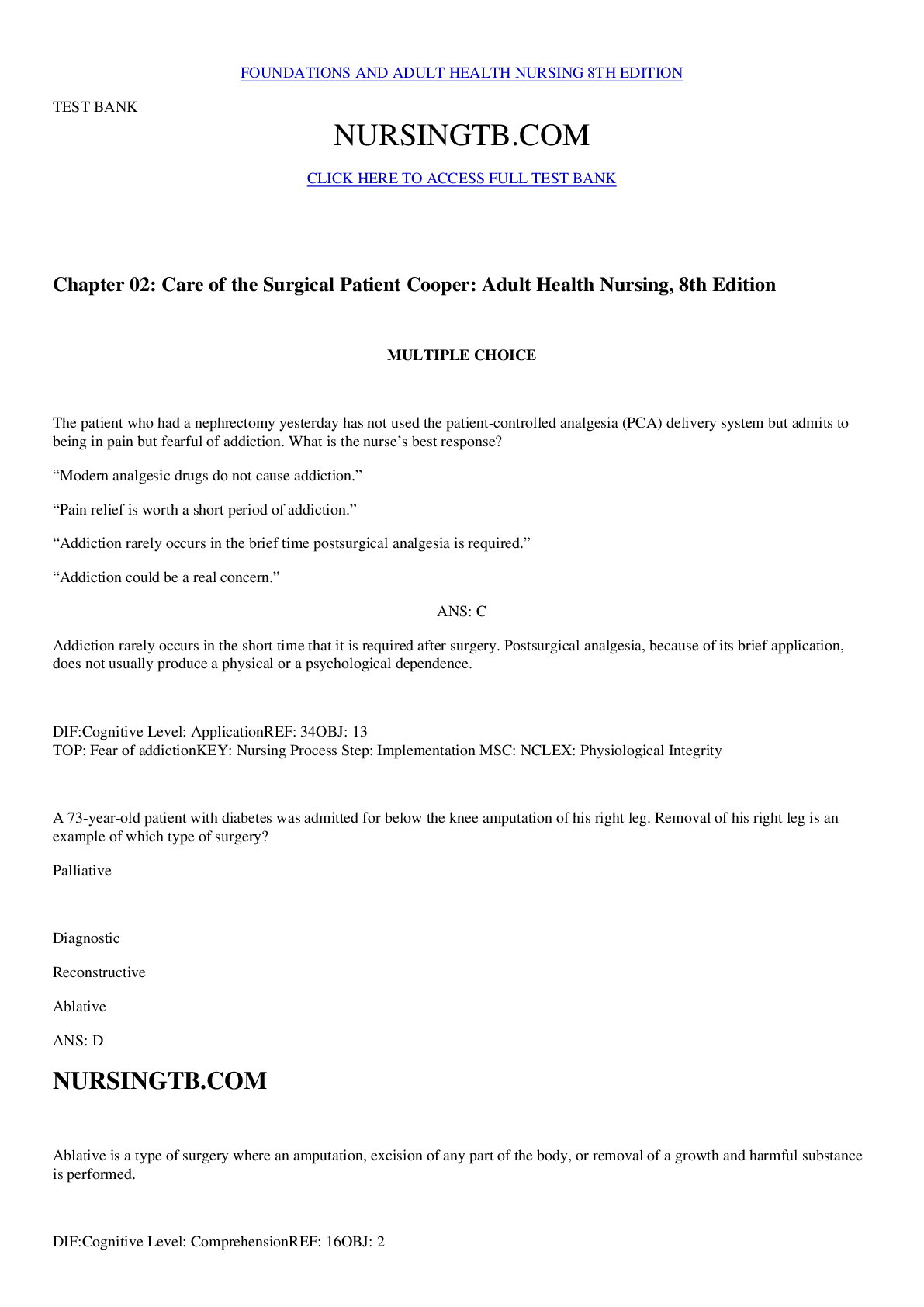
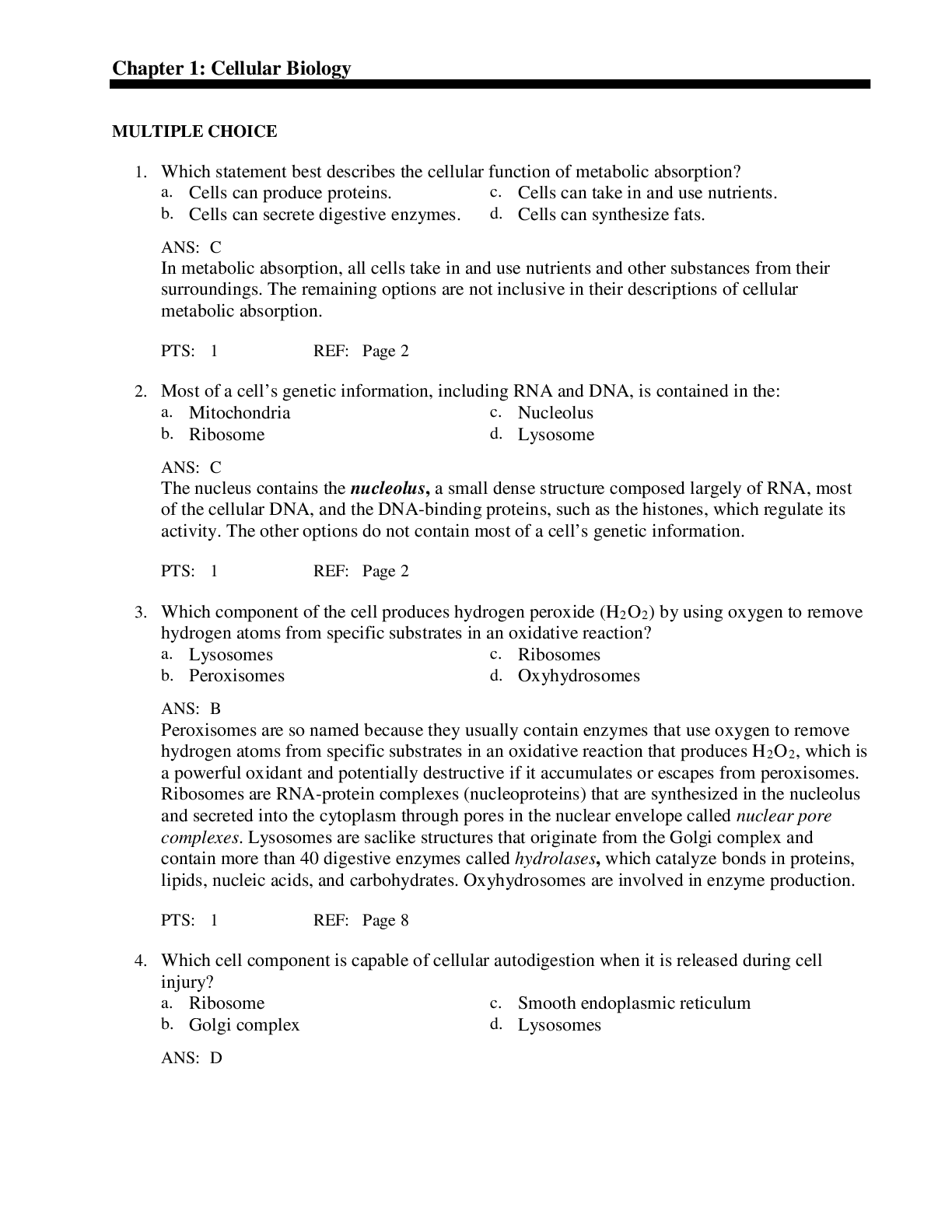
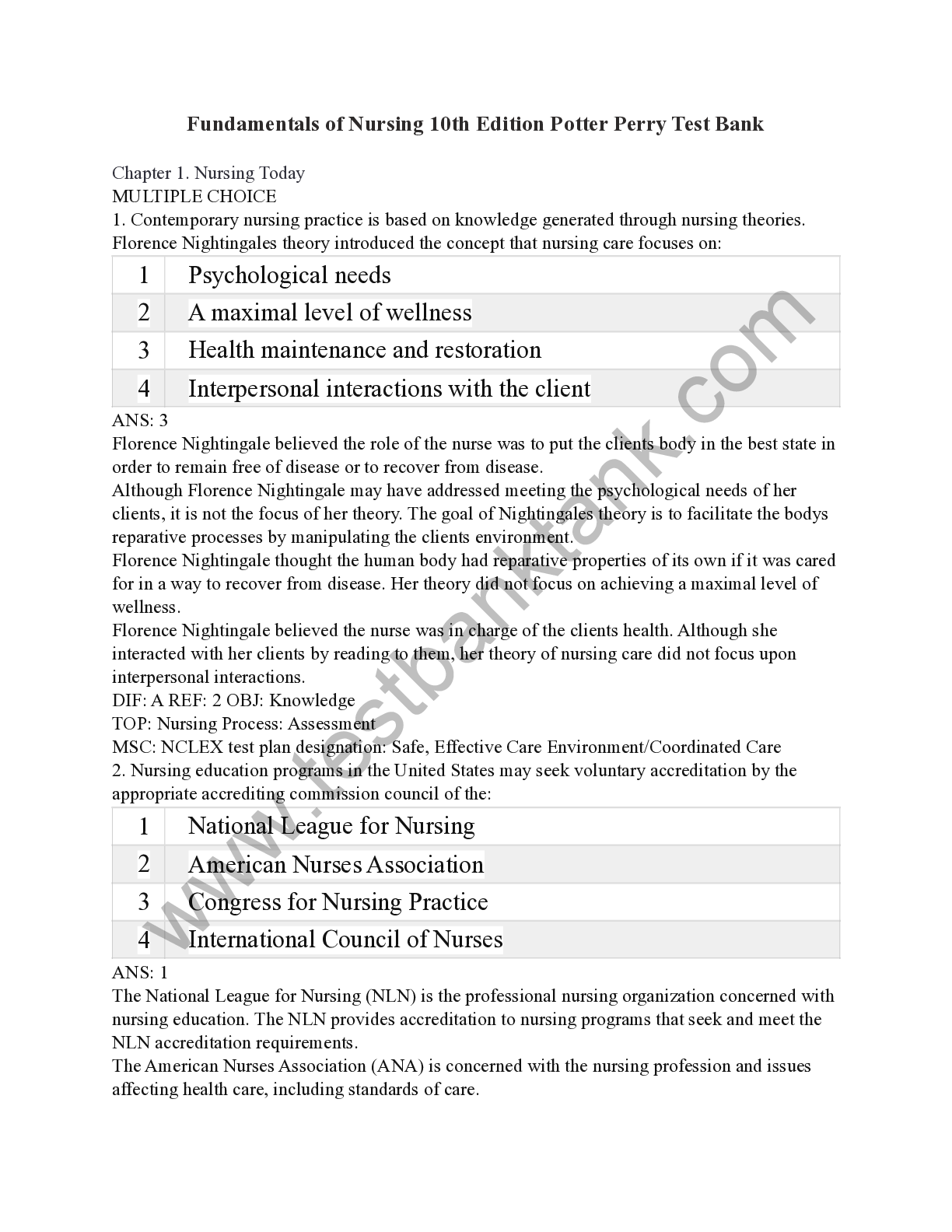
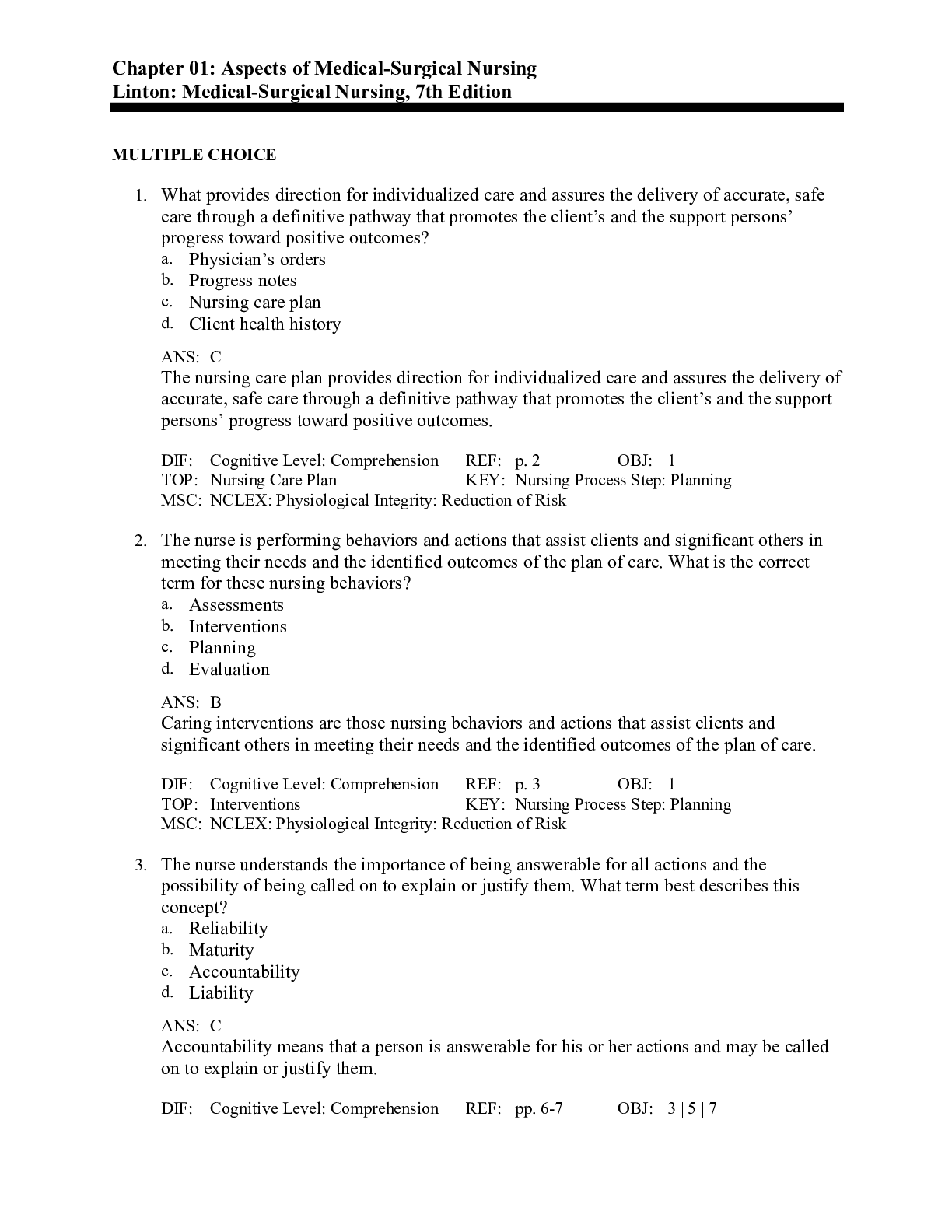
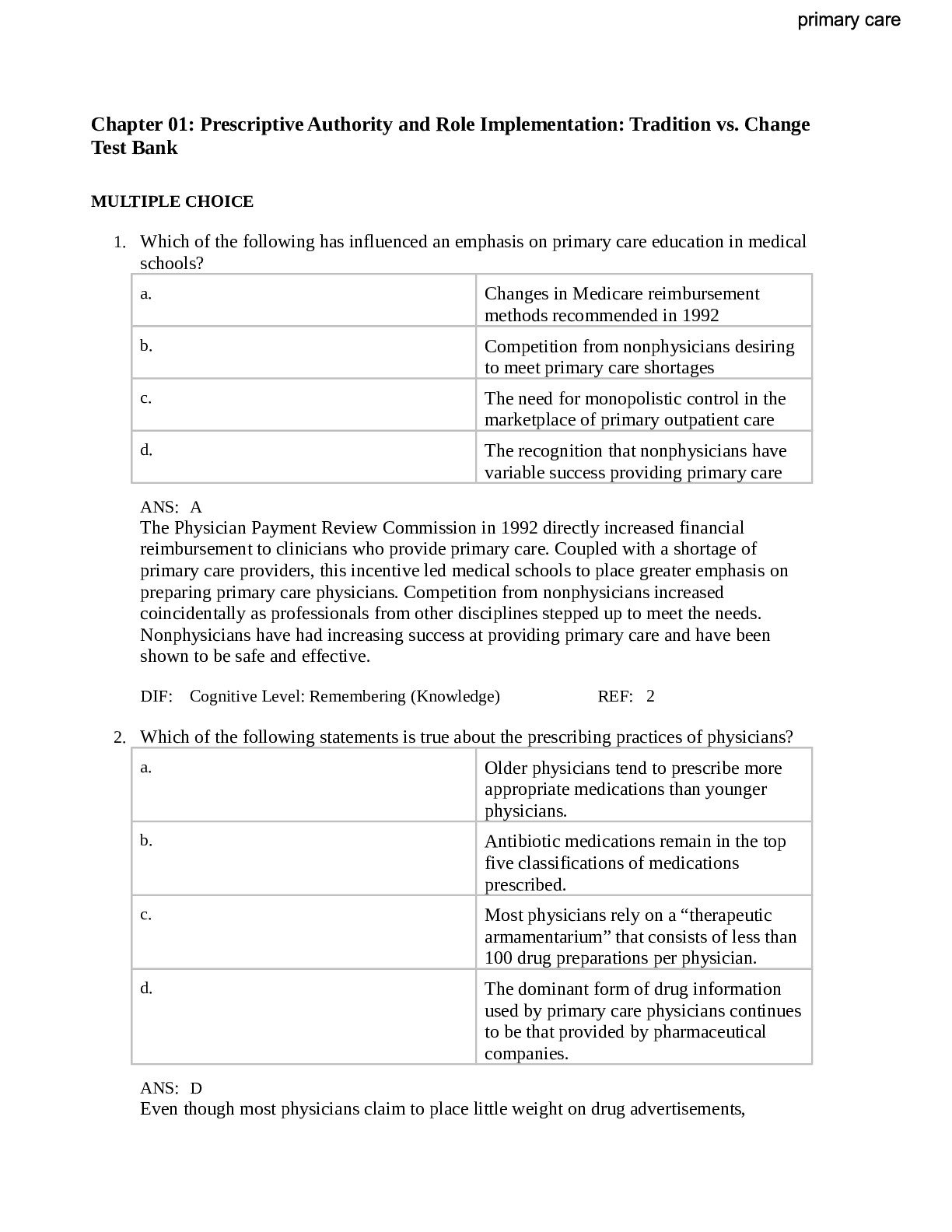
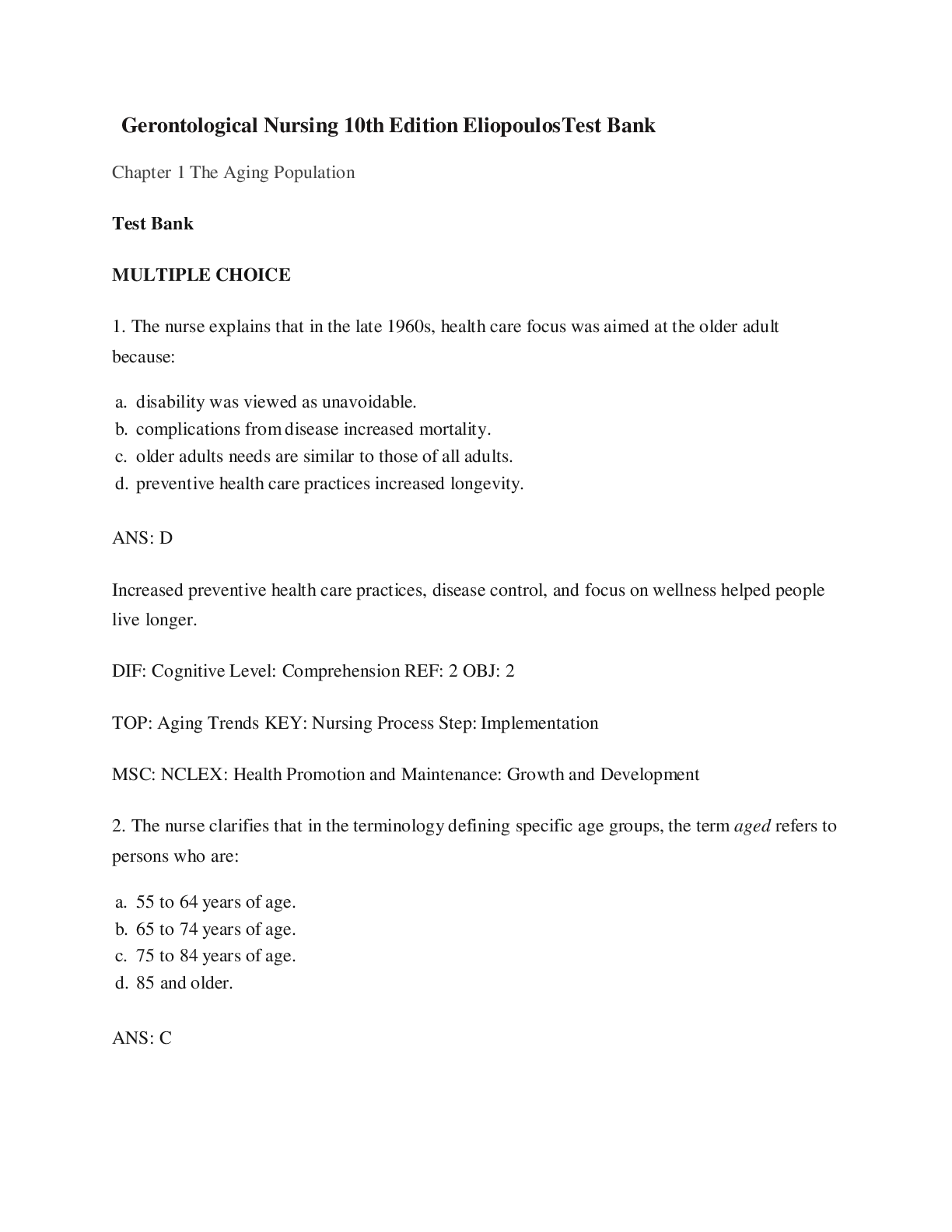
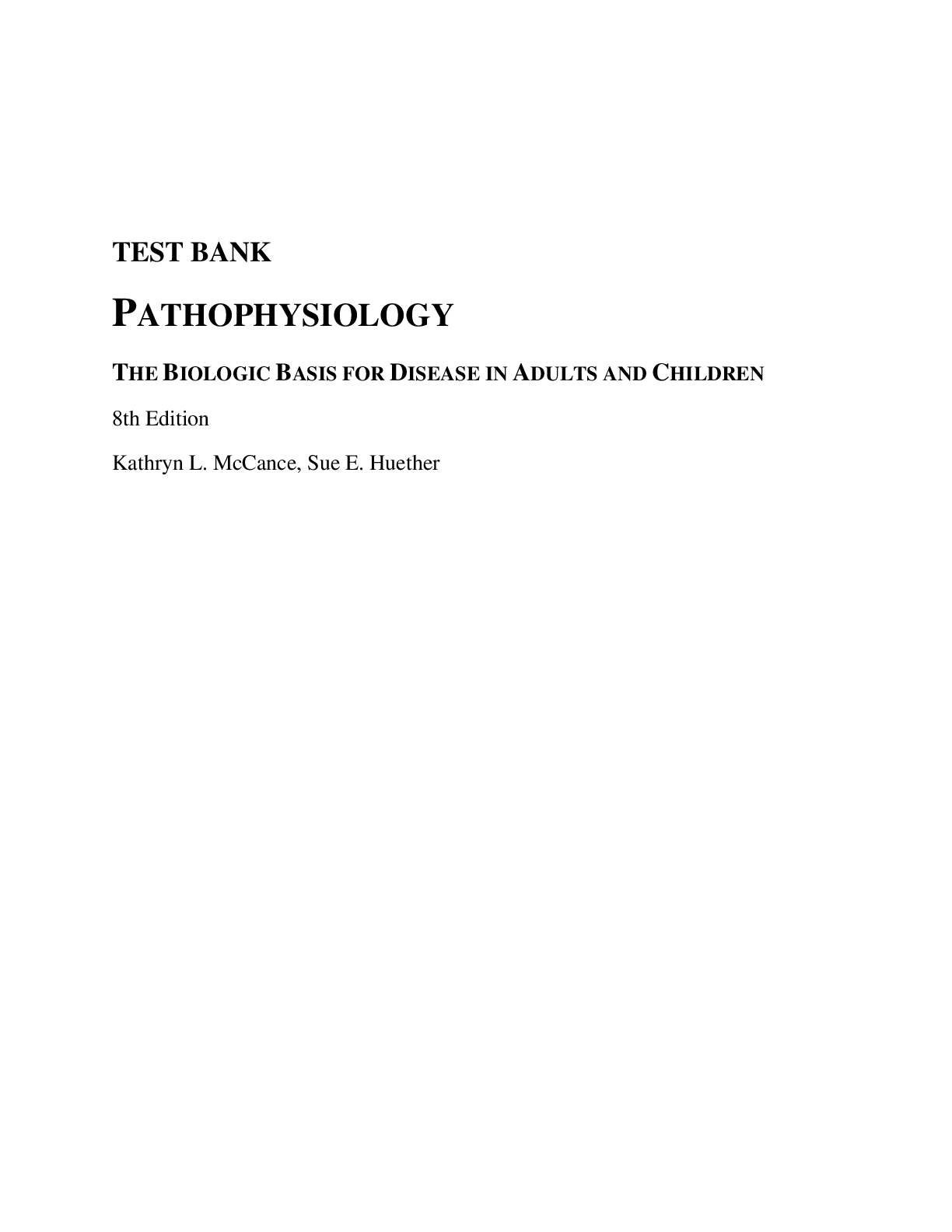
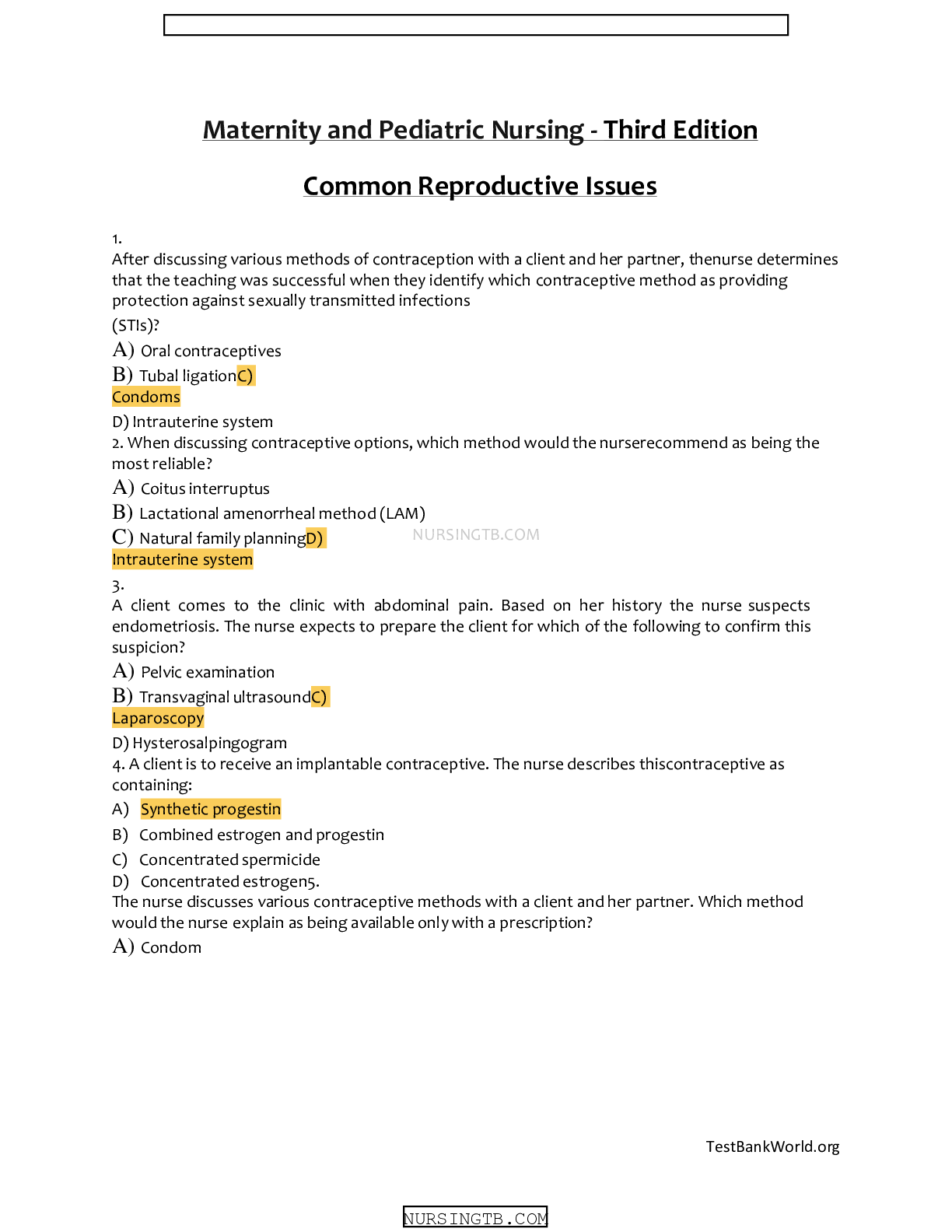
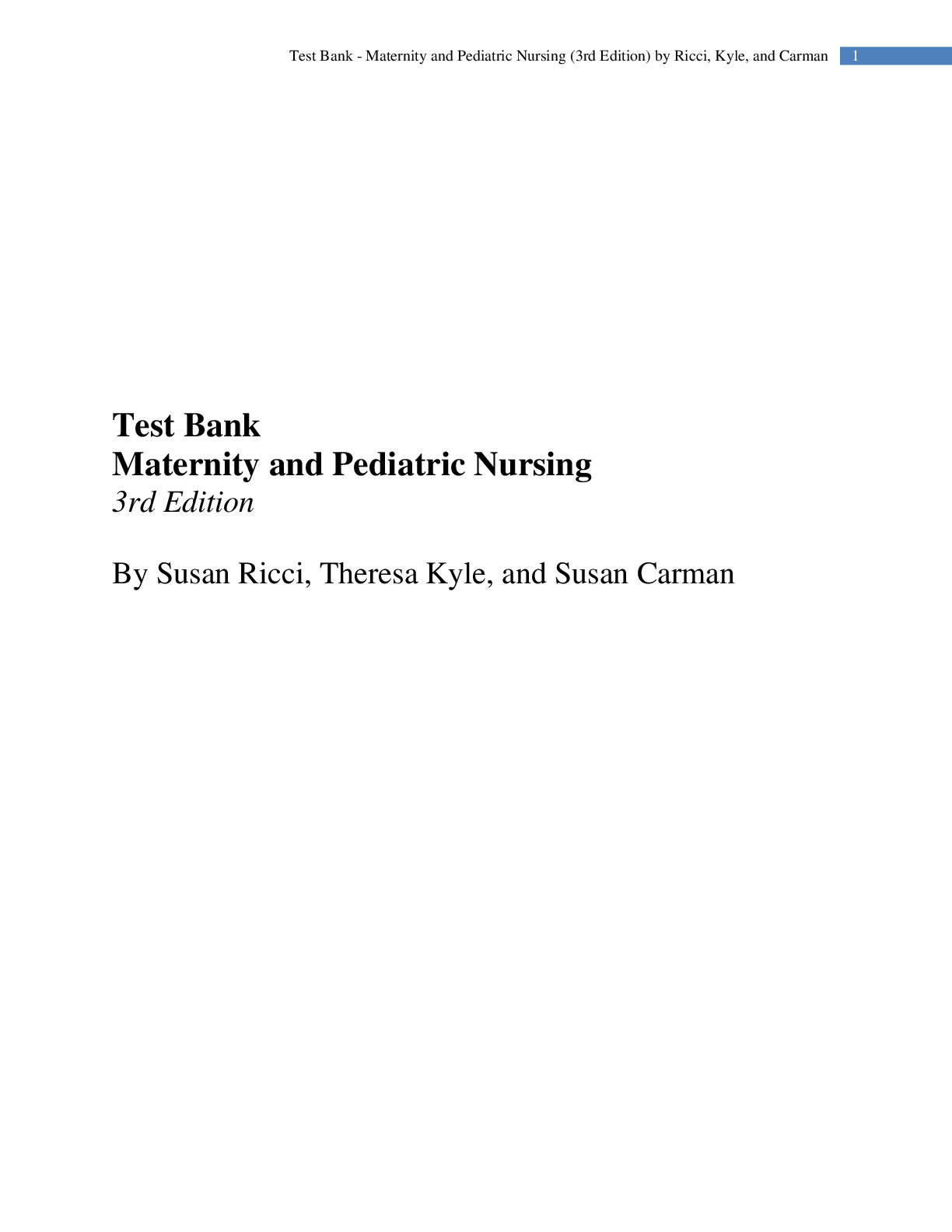
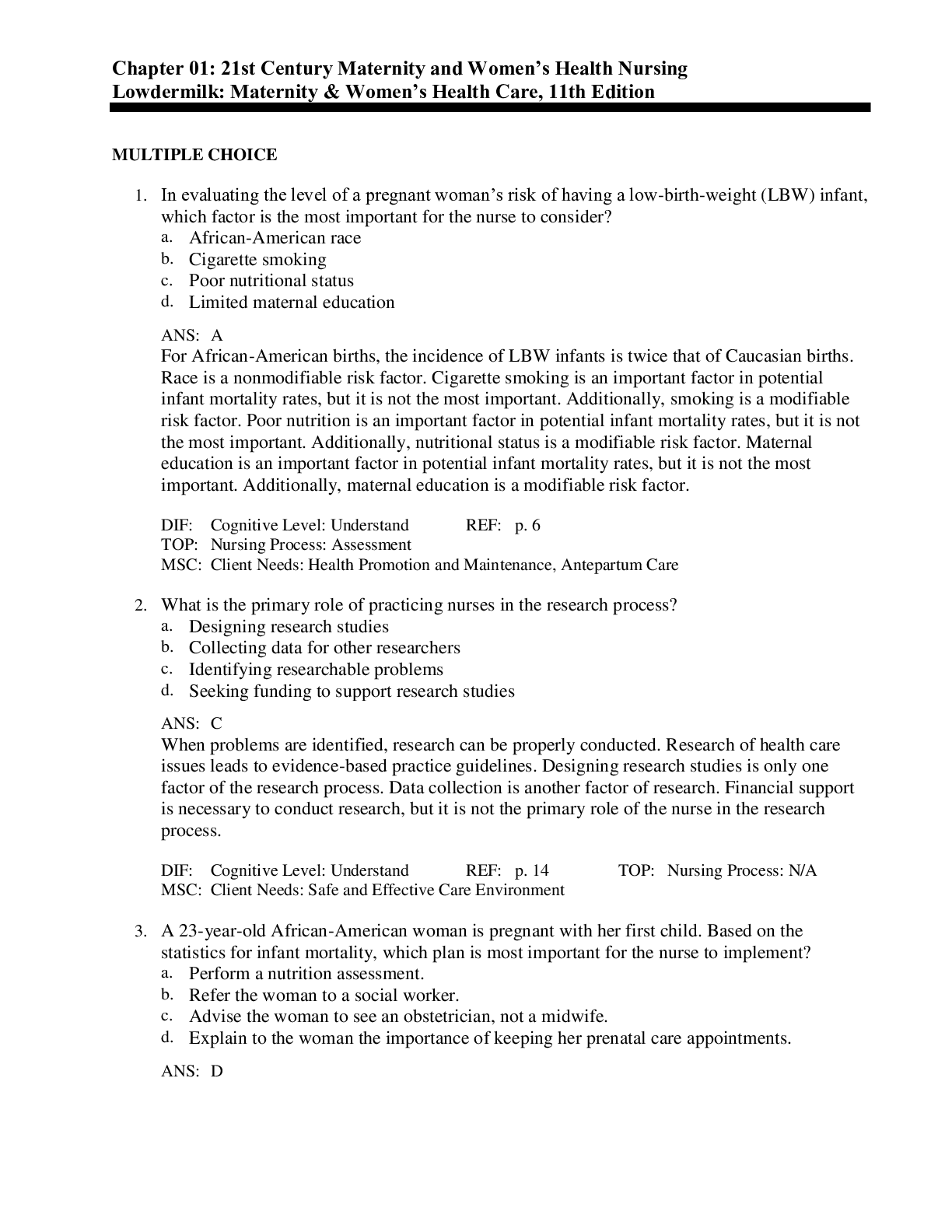
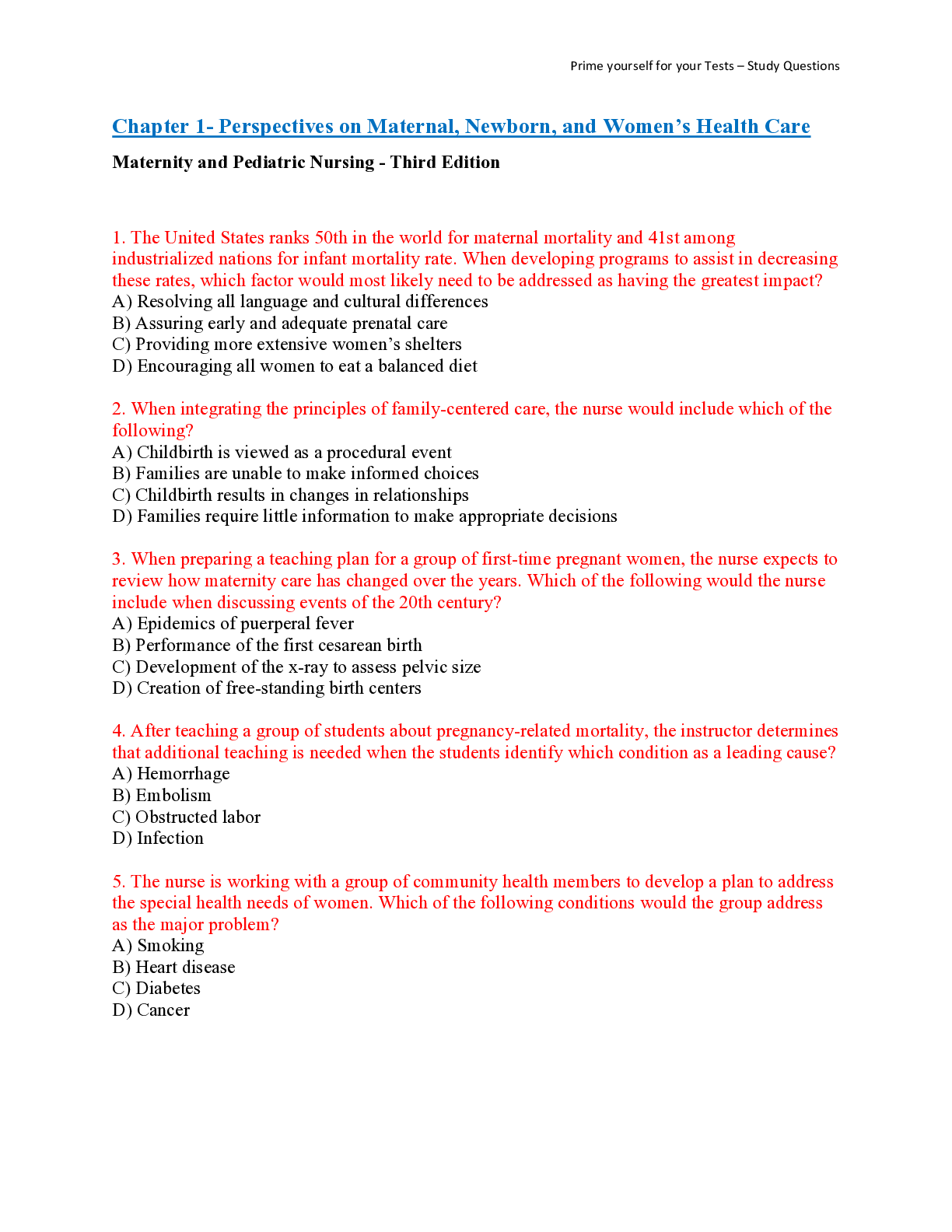

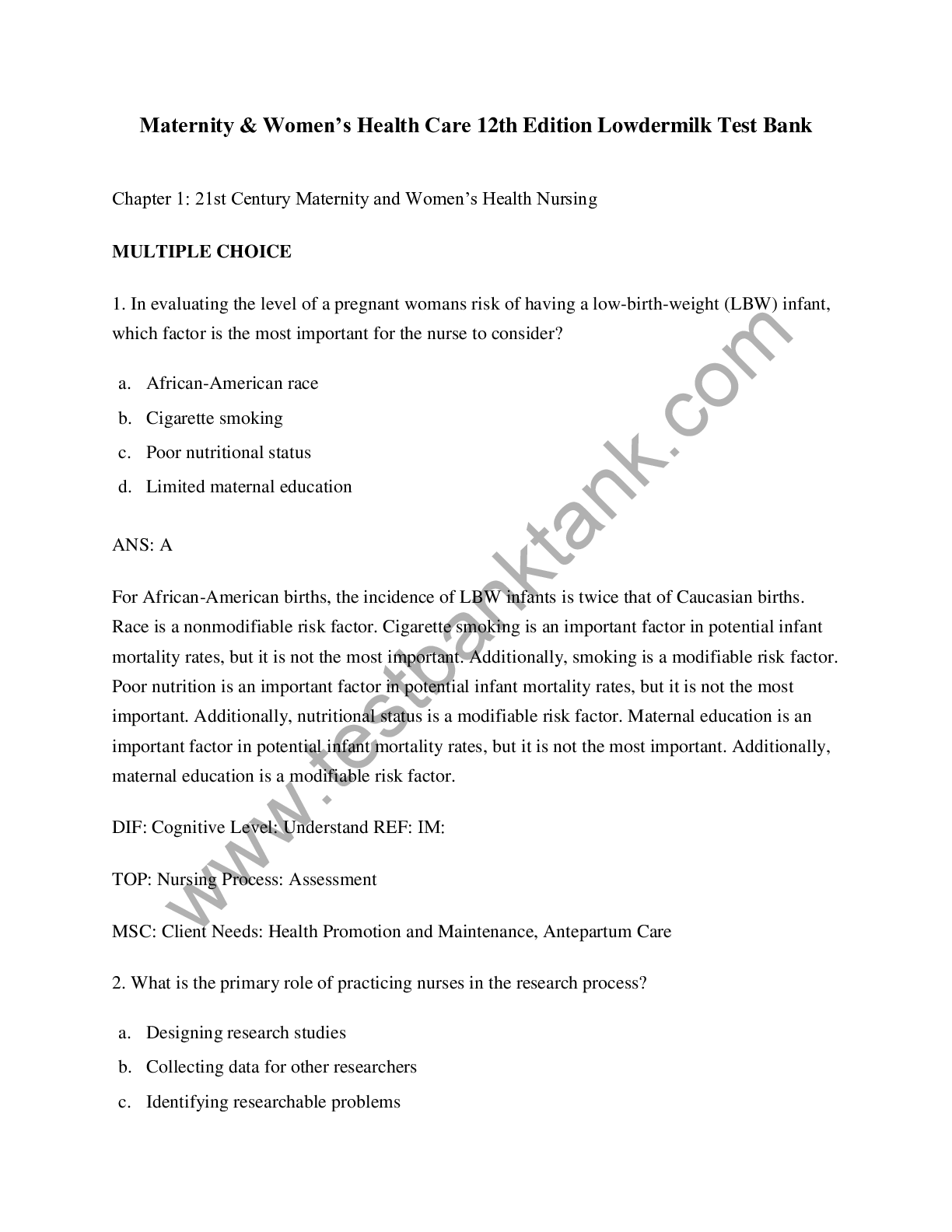
 by Ricci, Kyle, and Carman (all chapters).png)

